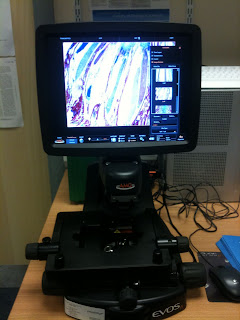Monitoring a cell sort can, hopefully, be a pretty mundane experience. If its interesting and exciting its probably indicative of a bit of a stressful time as this usually involves removing clogs from the nozzle, general cleaning of the system and lots of cell filtering! This morning I am doing a sort where the researcher wants to enrich her low GFP transfection efficiency in order to do protein analysis on her samples. At present endogenous, wild type, protein levels in the majority of the cells are masking the effects of her mutated protein. She therefore requires a higher proportion of cells to be positive for her protein of interest.
I've currently set up the sorter in readiness for her cells at 11am; fluidics started and the stream is running. It all looks OK so far. We are doing a sort through a 100um nozzle at 20psi on the FACSAriaIIu system. I will do the calibration at 10.45am with the drop delay beads.
10.45am
Small amount of spraying on the first stream so I sonicated the nozzle in 5% contrad for 25 seconds, which had no ill effect on the integrated o-ring. Should be fine. The accudrop beads went through fine so just waiting for the samples now.
11.30am
Samples filtered and parameters set up on mock transfected cells. All look good. Primary cells have a decent 40% transfection efficiency...lets see how they do!
12.00pm
First tube of collected cells off, good recovery with >95% positive cells in the sorted fraction. Currently running GFP control cells, tfx not much higher surprisingly.
12.30pm
HEK293 cells on now. Huge numbers of cells cf the first cell line. Have had to dilute the sample four fold to get the flow rate low enough to sort! Should have plenty of cell here! Good tfx efficiency too. Will collect 5x10e5, then swap to control GFP tfx cells and collect similar number I hope!
12.40pm
Hmm! Amplitude on the software went up to its max and stopped my sort :-p need to reset my stream now and redo Accudrop to ensure still ok.
1pm
Back up and running and looking good again. Think I had a bit of an air leak and some bubbles in the bubble filter causing turbulence. Cleared by bleeding with a syringe. Finish collecting this batch and then collect GFP control sample.
1.30pm
Woo-hoo! All done and dusted! Apart from the hiccup earlier all good, really pleased with recoveries >95%. Interesting as the researcher used a new protocol for treating the 293 cells and they were much happier in general (fewer dead cells) and the recovery % was really good cf to previous sorts with this cell line. Shut down now, then lunch!!
 |
| Density plot showing the negative (mock) HEK293 cells |
 |
| Pre-sort GFP transfected HEK293 cells |
 |
| Post sort analysis of collection tube...all good :) |














